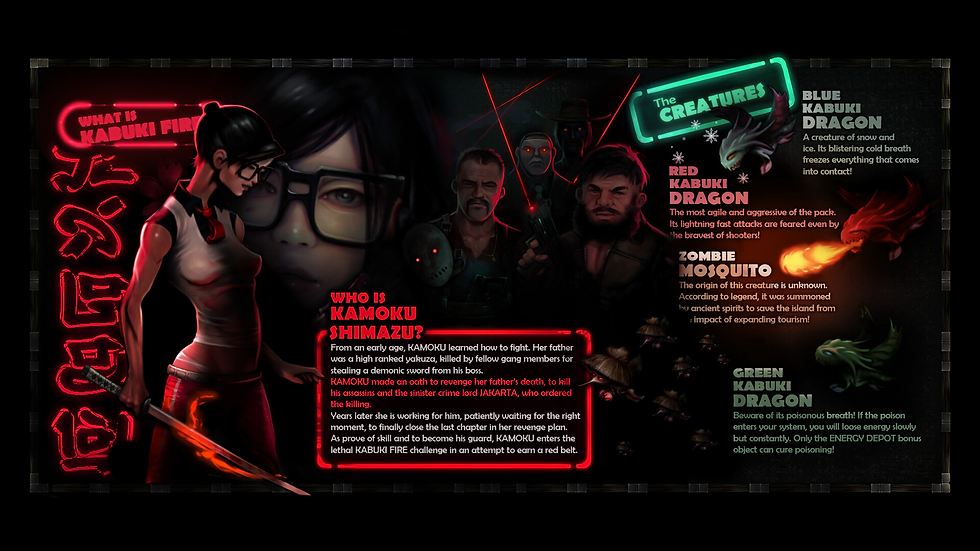KABUKI FIRE
- Hubert Spala
- Sep 3
- 3 min read
When I was about 10 years old, one of the weekly school rituals was a visit to a local pool for swimming lessons. Swimming itself was quite a pleasant experience and good fun, but the real deal awaited us in the pool lobby – a few delightful and eclectically picked arcade machines. There was Mortal Kombat! Metal Slug! That bubble game where you controlled a cutesy dinosaur shooting colorful bubbles (Puzzle Bobble, though back then I just thought of it as “the bubble thing”). It was a magical time, the crown jewel of each weekly visit. And with a crowd of eager boys, it was like a miniature experiment in social strata. The rich lads with their own allowances flexed their financial fluidity by buying tokens to play, while the rest of us watched in awe and jealousy.
All that waxing nostalgic serves a purpose: it has been forever since I played a game that truly felt like an arcade experience. KABUKI FIRE is exactly that – a plunge back into the days of yore, a game that feels like standing in front of a cabinet, swallowing your coins with brutal hunger. Of course, as a PC indie title, it doesn’t actually eat quarters beyond your initial purchase, but the sensation remains. Both the presentation and the outrageous setup capture that arcade soul: rough difficulty, pure score-based progression, and no pretensions.
The best part is how faithful KABUKI FIRE is to the arcade vibe. Everything is on point, from its storytelling to the user interface. You play as Kamoku Shimazu, a daring young yakuza member who enters a deadly competition on a zombie-infested island full of evil spirits. Armed with two guns, limitless ammo, and hopes of earning his crime boss’s trust, his goal is simple – shoot everything that moves with extreme prejudice. It’s silly and audacious, just like Contra, House of the Dead, or Time Crisis. Back when plots were direct, outrageous, and merely there to justify why you’re blasting zombie mosquitoes and magical dragons.

Of course, like most arcade shooters, the story hardly matters. It’s a decoration, a bit of flair on top of the gameplay. The core here is as ancient as it gets: a light-gun shoot’em up where you’re a crosshair on the screen, testing your reflexes and accuracy. The simplicity feels refreshing – clicking on enemies to make them vanish is a timeless thrill.
What makes KABUKI FIRE stand out are its clever twists on this formula. In most shooters, you take damage when enemies land an attack or when projectiles reach your character. Here, projectiles don’t aim at a character – they aim at your crosshair. Since the crosshair is you, survival depends on dodging with sharp mouse flicks, weaving between incoming fire. It’s a small change, but it makes the game more engaging – and much harder.
Another smart design choice is the interface. Highly stylized to match the hand-painted art style, it contains all the info you need while doubling as a temporary safe zone. Overwhelmed? You can duck into the UI for a breather. But linger too long, and it punishes you with life drain, a neat anti-camping mechanic that forces risk-reward decisions.
As tradition demands, there are bonuses – rockets, sawblades, explosions, frost golems. The variety isn’t vast, but it’s enough for a compact game like this. And compact it is: each run takes around five minutes if you survive, though getting your first clear on a real difficulty will take many tries. After that, it’s all about the most ancient arcade pursuit – the high score. The game even rewards mastery with colored belts as you climb the score ladder.

It’s short, but it nails the rhythm that games like Galaga, Point Blank, or Virtua Cop once thrived on – addictive repetition, instant restarts, and the eternal chase for “just one more run.” And as a bonus, it doubles as a sneaky FPS training exercise, sharpening aim and reflexes in a fun way.
KABUKI FIRE brought a genuine smile to my face. It’s a small, simple game – maybe an hour or two of play before you’ve had your fill – but it’s also a wonderful reminder of a type of gaming I’d almost forgotten. Gorgeous art, sharp vibes, and pure arcade spirit, all neatly packed into a modern indie wrapper. It won’t keep you hooked for months, but it does something far rarer: it bottles the fleeting magic of an arcade cabinet and puts it right on your PC.





Comments